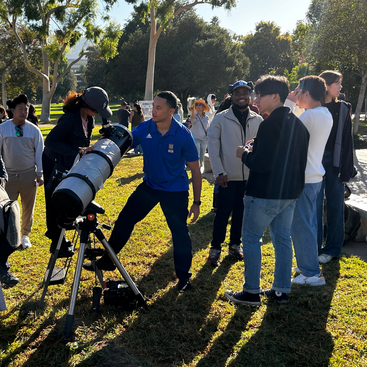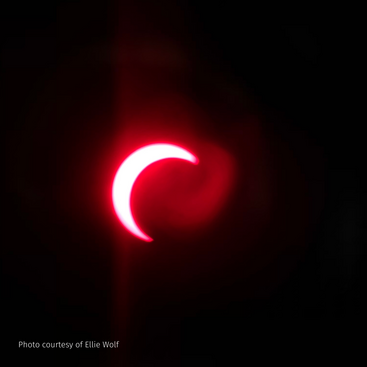
RIVERSIDE, CA - Hundreds of visitors flocked to UC Riverside last Saturday for an annular solar eclipse viewing party hosted by the College of Natural & Agricultural Sciences' (CNAS) Physics & Astronomy department.
Unlike a total eclipse, an annular eclipse in one in which the moon does not cover the entire disc of the sun, so that a ring of sunlight surrounds the shadow of the moon.
With the help of high-powered telescopes, eclipse glasses and hand-made pinhole cameras, viewers were able to safely enjoy the sight of the moon passing in front of the sun over a three hour period.
According to event creator and host Alex de la Vega, UC Riverside postdoctoral scholar and astronomer, viewing solar eclipses has led to several scientific breakthroughs throughout human history.
"During total solar eclipses, when the Moon completely blocks the Sun, the outermost layer of the Sun's atmosphere, called the corona, is visible," explains Dr. de la Vega. "The corona was discovered during eclipses, and viewing eclipses led to the discovery of helium, the second element in the periodic table, in the 19th century."
Dr. de la Vega also points out that eclipses have fundamentally changed the way scientists observe the world around them.
"There's an astronomical observing technique called coronagraphy, wherein astronomers block out stars to discover fainter objects that could not have been seen otherwise," he says. "This technique is inspired by the Moon's blocking of the Sun during eclipses."
When setting up the event, Dr. de la Vega and his team from the Physics & Astronomy department took special precautions to ensure guests could enjoy the eclipse safely. Guests were able to view the eclipse through motorized telescopes equipped with solar filters, which only let in 0.001% of the sun's light.
"It's important to remember that looking directly at the sun without protection is dangerous, even if the moon blocks it," cautions Dr. de la Vega. "The equipment we will use, [telescope and] eclipse glasses...are approved for direct viewing of the sun."
The event attracted UCR students, faculty and staff, local community members and children of all ages. Guests were also invited to make their own pinhole cameras through which to view the eclipse.
Constructed out of paper and aluminum foil with a tiny hole in the center, pinhole cameras serve as projectors for bright objects, allowing viewers to project the changing image of the sun onto a flat surface in from of them for safe viewing.
Cameron Wolf, a fourth grade teacher from Parkridge Elementary School in Corona, CA, praised the event for introducing younger students to scientific concepts and career paths.
"Events like this are important for fourth graders because it shows students what is possible as they get older and start thinking about college," says Mrs. Wolf.
Mrs. Wolf also credits the event with teaching her students that science is ever-present in their daily lives.
"One of the great things about the program today was that students were able to see how to create a pinhole camera out of things that they can find in their own kitchen, which helps students understand that science is everywhere," she explains. "You don't have to have special equipment to be a scientist...you can just be one!"
Viewing party guests were treated to a unique spectacle as the moon moon obscured approximately 72% of the sun...unique in that eclipses are a relatively rare astronomical phenomenon.
"Total solar eclipses occur about once every one and a half years, and partial solar eclipses occur two to five times a year," explains Dr. de la Vega. "However, for a specific spot on Earth, the average amount of time between total eclipses is about 375 years. For example, Chicago will see a total eclipse in 2205, nearly 400 years after its last total eclipse in 1806."
Regarding annular eclipses, Dr. de la Vega explains that they "happen once every one or two years, and for a specific location on Earth, an annular eclipse occurs about every 224 years."
So when can the Riverside community expect to see its next solar eclipse?
According to NASA's Jet Propulsion Laboratory, community members will be treated to a partial solar eclipse on April 8, 2024. Get your pinhole cameras ready!


